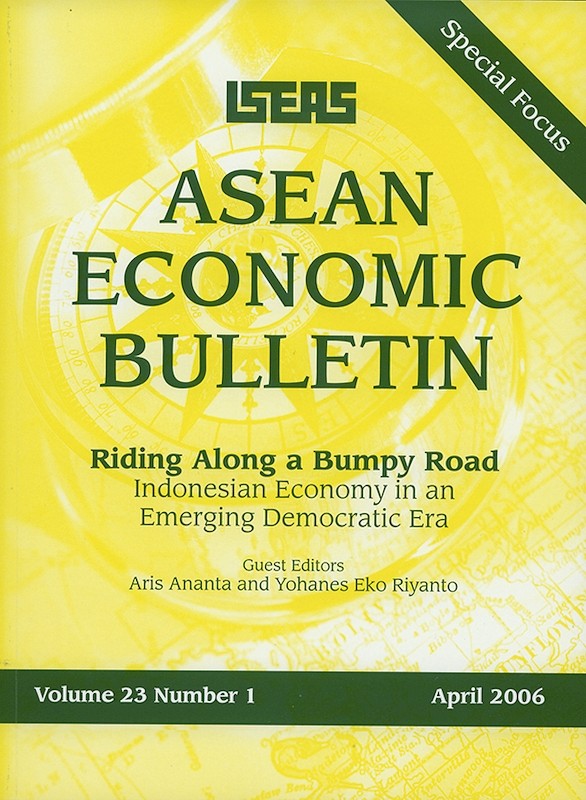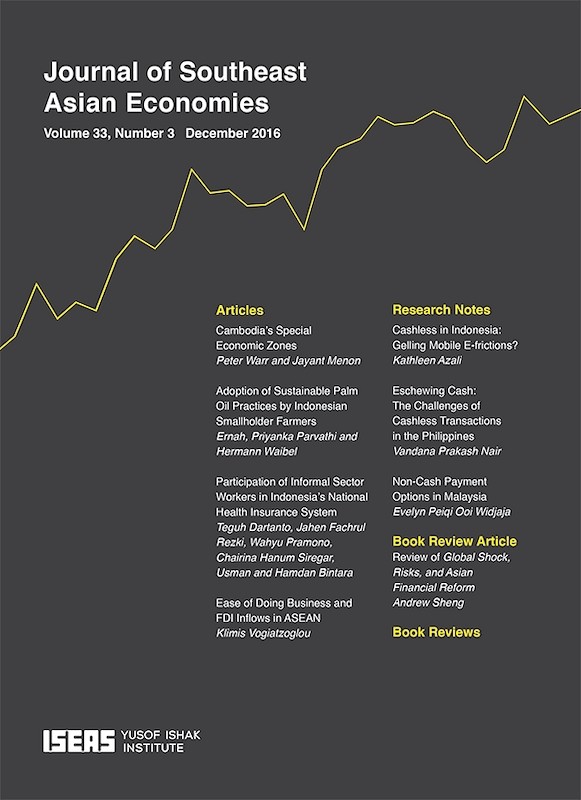ASEAN Economic Bulletin Vol. 23/1 (Apr 2006). Special Focus on "Riding Along a Bumpy Road: Indonesian Economy in an Emerging Democratic Era"

Date of publication:
April 2006
Number of pages:
138
Code:
AE23/1
Contents
-
ASEAN Economic Bulletin Vol. 23/1 (Apr 2006). Special Focus on "Riding Along a Bumpy Road: Indonesian Economy in an Emerging Democratic Era"
-
Preliminary pages
- ARTICLES
-
Riding Along a Bumpy Road: Indonesian Economy in an Emerging Democratic Era, by Aris Ananta, Yohanes Eko Riyanto, authors
-
Corruption and Business Uncertainty in Indonesia, by Ari Kuncoro, author see abstractThe main purpose of the paper is to analyse the local business environment in Indonesia after decentralization. Corruption or rent-seeking behaviour is focused on bribery and the market for local (district) government regulatory goods such as Business license, fire safety inspection, compliance to environmental regulations, local tax appraisal, building permits, and employment contract inspection. We abstract from other rent-seeking activities like lobbying governments for particular projects, industrial protection, and exclusive monopoly rights. In the model, government regulation can be customized to extract rent. A firm has to spend time and money to reduce its burden. The paper uses a method based on the standard theory in economic analysis that a firm would engage in negotiation if the burden is sufficiently high, and only if the marginal effectiveness of bribes after taking into account uncertainty exceeds the marginal cost of bribes in negotiation. The empirical results of the model suggest that uncertainty plays a significant role in affecting bribe level. In addition, from the way the uncertainty variable is constructed, there is also an indication that some fragmentation of bribe collection system has taken place.
-
Regional Income Disparity in Indonesia: A Panel Data Analysis, by Budy Resosudarmo, Yogi Vidyattama, authors see abstractRegional income per capita disparity has become a crucial topic in Indonesia since the beginning of the 1990s. However, the main reasons for the existence of this income disparity remain a puzzle. This paper utilizes a panel data technique and the general specification growth model to estimate the provincial growth of income per capita in Indonesia for the 1993-2002 period to investigate the determinants of the country's regional income disparity. The main findings are, first, despite the existence of regional income disparity, there is a conditional regional income per capita growth convergence; and second, saving of physical capital, trade openness and the contribution of the gas and oil sectors are the determinants of this provincial income per capita growth.
-
The Role of Medical Care in Explaining the Link between Health and Economic Resources, by Wankyo Chung, author see abstractUsing data from the third wave of the Indonesian Family Life Survey (IFLS3), this study analyses the relationship between economic resources and individual health status, controlling for other individual health risk factors. The study finds that economic resources measured by equalized expenditure have a statistically significant positive effect on individual health. Economic resources are also found to have a sizable and significant effect on the utilization of medical care. After all, it is utilization of medical care that plays an intermediary role in explaining the link between economic resources and health. Consistent results are found when both self-reported and nurse-assessed health indicators are used and when both broad and more specific measures of medical care utilization are used.
-
The New Indonesian Social Security Law: A Blessing or Curse for Indonesians?, by Alex Arifianto, author see abstractThe Indonesian Government has recently passed a new national social security law, which supporters have said would make the existing social system works better for the beneficiaries and would extend social security coverage to more workers and their families, both in the formal and informal sector. However, opponents have stated that the new law is flawed in many ways. The paper attempts to critically analyse the law and to predict its possible impacts on Indonesian workers and economy in general. From this analysis, we can conclude that there are several serious flaws in the government plan as outlined in the new law, such as a worsening of Indonesia's labour market conditions, financial unsustainability, and added pressures on the state budget. Also, it does not allow competition in the provision of social security benefits to Indonesians. A better policy would be to strengthen the family support system, which has been the major source of old-age support for elderly Indonesians. In addition, Indonesia should seriously consider adopting a social security scheme based on the widely used multi-pillar approach to replace the current public social security monopoly.
-
Intra-household Differences in Education and Home Leaving in Indonesia, by Firman Witoelar, author see abstractThis paper investigates some of the underlying factors determining the probability of household division, defined here as the event when an adult leaves his or her original household, utilizing data from two waves of the IFLS (IFLS1-1993 and IFLS3-2000). Borrowing the empirical framework suggested by Foster and Rosenzweig (2002), I estimate the probability of household division by the subsequent waves of the survey, using household variables from an earlier wave as the explanatory variables. The findings suggest that education variables play an important albeit limited role in determining household division. There is evidence that higher education of the household head is associated with lower propensity of an adult household member to leave. On the other hand, higher maximum years of schooling of other members in the household are associated with higher probability of household division. These results, along with the finding showing that rural households are more likely to divide, indicate that household division in Indonesia may largely be associated with the mobility of young, more educated members from rural areas. While the empirical framework is based on a collective household model, the results can also be explained within the context of unitary household model.
-
Designing an Integrated Financial Supervision Agency: Selected Lessons and Challenges for Indonesia, by Reza Yamora Siregar, William E James, authors see abstractHaving initiated reforms in the financial sector in late 1997, the government of Indonesia also introduced a new Central Bank Independence Act in early 1999. The next task for the government is to devise a safety net system for the financial sector, which includes the possibility of establishing an integrated financial sector supervisory agency. This study draws essential lessons from the experiences of other countries to highlight a number of key challenges facing Indonesia in designing its integrated financial sector supervisory agency, especially at the early stages.
-
A Drastic Reduction of Fuel Subsidies Confuses Ends and Means, by Iwan J. Azis, author see abstractIn order to reduce the mounting pressure on government budget due to rising expenditures related to all sorts of subsidies, including those for the banking sector and domestic fuel consumption, the Indonesian Government has opted to cut only the fuel subsidies. Following the surge of the world price of oil, the size of the cut was huge, causing the average domestic fuel prices to increase by more than 120 per cent. It is argued in this paper that such a policy is ill-advised. A partial reduction, not an enormous cut, would have been sufficient if it is complemented with a fractional cut of sovereign domestic debt payments. Based on a set of simulations on a financial general equilibrium model, it is shown that slicing subsidies for the banking sector, providing that the saved money are spent on agricultural-related infrastructures, could produce a favourable outcome in terms of income distribution and poverty conditions without deteriorating the macroeconomic stability or injuring investors confidence. Compared with the fuel subsidies cut, the number of population affected by such a policy will also be much smaller. Thus, a drastic and massive reduction of fuel subsidies is unnecessary, especially considering the adverse socioeconomic and political repercussions of it.



![Journal of Southeast Asian Economies Vol. 30/1 (Apr 2013) [formerly ASEAN Economic Bulletin]](/cover/AE30-1.jpg)


